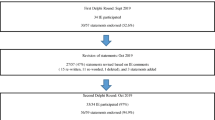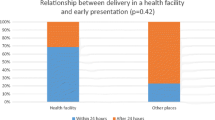Abstract
Purpose
We evaluate a single-institution cohort of mothers contemporaneous with the Management of Myelomeningocele Study (MOMS) trial to determine the generalizability of MOMS results and compare shunt rates.
Methods
A retrospective chart review identified patients with myelomeningocele born between 2003 and 2009. We applied MOMS eligibility criteria and compared sociodemographic variables between patients at our institution who would have been eligible or ineligible and MOMS participants. Finally, we applied the original MOMS primary outcome and the revised primary outcome to our cohort.
Results
Of the 78 patients, 55 (70.5%) were eligible for the MOMS trial. Mean maternal age, race, and marital status were different from both MOMS groups. Comparing our series to MOMS postnatal shows fewer female infants (44.9 vs. 63.8%, p = 0.017) and more thoracic lesions (12.8 vs. 3.8%, p = 0.038). Shunt rates in our cohort (84.6%) were higher than MOMS prenatal and similar to MOMS postnatal (44.0 and 83.7%, respectively). Fewer children met the original primary outcome than the postnatal group (84.6 vs. 97.8%, p = 0.002). There was no significant difference between our cohort and the prenatal group (84.6 vs. 72.5%, p = 0.058). When applying the revised criteria, we find the opposite: a significant difference between local and MOMS prenatal (84.6 vs. 49.5%, p < 0.001) but no difference between the local group and MOMS postnatal (84.6 vs. 87.0%, p = 0.662).
Conclusions
Mothers in our cohort differ from mothers enrolled in MOMS via several sociodemographic factors. Baseline fetal characteristics show a significantly higher functional lesion level in between our cohort and MOMS. Treatment of hydrocephalus in our series tracks almost identically with original MOMS shunt criteria. Revision of the criteria led to greater concordance between meeting criteria and receiving a shunt in MOMS patients, but changes the results in our series.
Similar content being viewed by others
References
Burmeister R, Hannay HJ, Copeland K et al (2005) Attention problems and executive functions in children with spina bifida and hydrocephalus. Child Neuropsychol 11:265–283. doi:10.1080/092970490911324
Elgamal EA (2012) Natural history of hydrocephalus in children with spinal open neural tube defect. Surg Neurol Int 3:112. doi:10.4103/2152-7806.101801
Januschek E, Röhrig A, Kunze S et al (2016) Myelomeningocele—a single institute analysis of the years 2007 to 2015. Childs Nerv Syst 32:1281–1287. doi:10.1007/s00381-016-3079-1
Morota N, Ihara S (2008) Postnatal ascent of the cerebellar tonsils in Chiari malformation type II following surgical repair of myelomeningocele. J Neurosurg Pediatr 2:188–193. doi:10.3171/PED/2008/2/9/188
Radcliff E, Cassell CH, Laditka SB et al (2016) Factors associated with the timeliness of postnatal surgical repair of spina bifida. Childs Nerv Syst 32:1479–1487. doi:10.1007/s00381-016-3105-3
Vinck A, Maassen B, Mullaart R, Rotteveel J (2006) Arnold-Chiari-II malformation and cognitive functioning in spina bifida. J Neurol Neurosurg Psychiatry 77:1083–1086. doi:10.1136/jnnp.2005.075887
Wiedenbauer G, Jansen-Osmann P (2006) Spatial knowledge of children with spina bifida in a virtual large-scale space. Brain Cogn 62:120–127. doi:10.1016/j.bandc.2006.04.003
Yeates KO, Loss N, Colvin AN, Enrile BG (2003) Do children with myelomeningocele and hydrocephalus display nonverbal learning disabilities? An empirical approach to classification. J Int Neuropsychol Soc 9:653–662. doi:10.1017/S1355617703940057
Bowman RM, Boshnjaku V, McLone DG (2009) The changing incidence of myelomeningocele and its impact on pediatric neurosurgery: a review from the Children’s Memorial Hospital. Childs Nerv Syst 25:801–806. doi:10.1007/s00381-009-0865-z
Bowman RM, McLone DG, Grant JA et al (2001) Spina bifida outcome: a 25-year prospective. Pediatr Neurosurg 34:114–120 doi: 56005
Kshettry VR, Kelly ML, Rosenbaum BP et al (2014) Myelomeningocele: surgical trends and predictors of outcome in the United States, 1988-2010. J Neurosurg Pediatr 13:666–678. doi:10.3171/2014.3.PEDS13597
Marreiros H, Loff C, Calado E (2015) Who needs surgery for pediatric myelomeningocele? A retrospective study and literature review. J Spinal Cord Med 38:626–640. doi:10.1179/2045772314Y.0000000229
Mayer S, Weisser M, Till H et al (2010) Congenital myelomeningocele—do we have to change our management? Cerebrospinal Fluid Res 7:17. doi:10.1186/1743-8454-7-17
Schoenmakers MA, Uiterwaal CS, Gulmans VA, Gooskens RH, Helders PJ (2005) Determinants of functional independence and quality of life in children with spina bifida. Clin Rehabil 19:677–685
Adzick NS, Thom EA, Spong CY et al (2011) A randomized trial of prenatal versus postnatal repair of myelomeningocele. N Engl J Med 364:993–1004. doi:10.1056/NEJMoa1014379
Tulipan N, Wellons JC, Thom EA et al (2015) Prenatal surgery for myelomeningocele and the need for cerebrospinal fluid shunt placement. J Neurosurg Pediatr 16:613–620. doi:10.3171/2015.7.PEDS15336
Grivell RM, Andersen C, Dodd JM (2014) Prenatal versus postnatal repair procedures for spina bifida for improving infant and maternal outcomes. Cochrane Database Syst Rev . doi:10.1002/14651858.CD008825.pub2CD008825
Author information
Authors and Affiliations
Corresponding author
Ethics declarations
Funding
Dr. Rocque is supported by NIH Grant 1KL2TR001419 and by the Kaul Pediatric Research Institute of Children’s of Alabama.
Conflict of interest
The authors declare that they have no conflict of interest.
Additional information
Nicholas M. B. Laskay and Anastasia A. Arynchyna contributed equally as first authors
Rights and permissions
About this article
Cite this article
Laskay, N.M.B., Arynchyna, A.A., McClugage, S.G. et al. A comparison of the MOMS trial results to a contemporaneous, single-institution, postnatal closure cohort. Childs Nerv Syst 33, 639–646 (2017). https://doi.org/10.1007/s00381-016-3328-3
Received:
Accepted:
Published:
Issue Date:
DOI: https://doi.org/10.1007/s00381-016-3328-3




